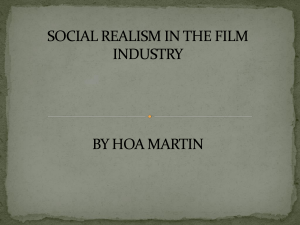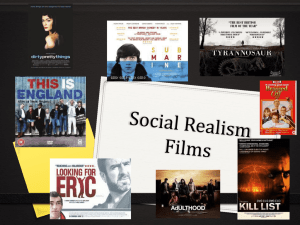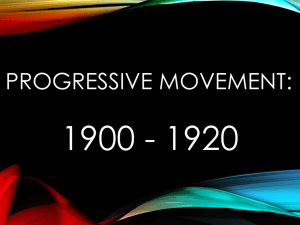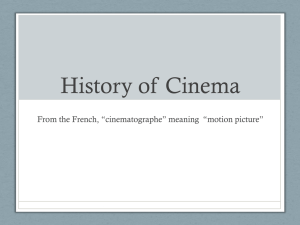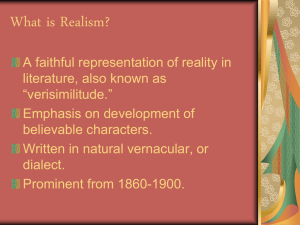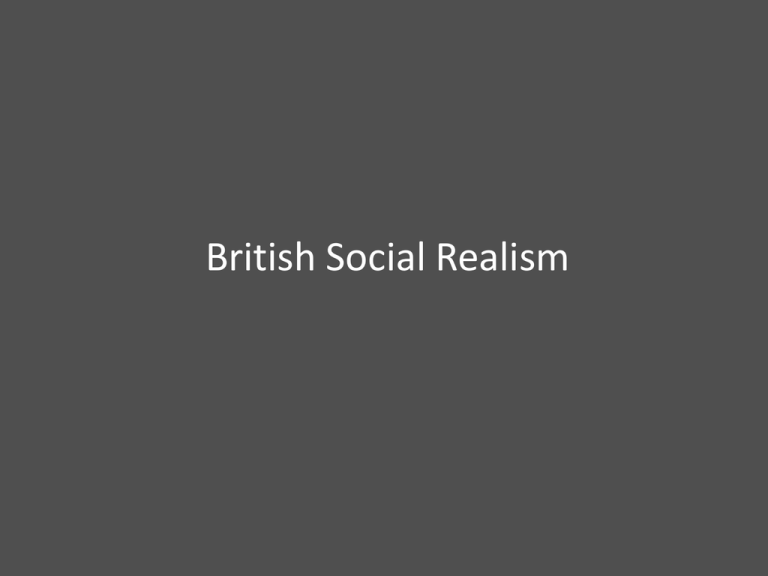
British Social Realism
Social Realism ...
Social realism is a genre of film that focuses on topical issues alive in a modern
society which is represented by different ideologies. Themes such as money, drugs,
prostitution and sex are quite usual in modern contemporary social realism films as
well as class, religion and political views. These themes are very popular today but
not all were involved in the early social realism storylines and films.
Social Realism ...
The forms and conventions for social
realism. The main forms and conventions
are; The use of unknown actors. This
supports the social realism genre because
the actors could be anyone which makes it
realistic. Social class is a very important
form and convention as most social
realism films deal with the working class
like ‘Billy Elliot’ directed by Steven Daldry.
The locations of a social realism film are
usually set around a council estate or run
down areas of different cities, but can be
nice neighbourhood. Usually a social
realism film deals with issues like drugs,
sex, poverty, prostitution, homosexuality,
alcoholism and crime. Social realism films
usually involve political views and religious
views.
The age is also important to the forms and conventions
of social realism. Most films use young teenagers and
young adults from 13 – 20. ‘Kidulthood’, ‘Kes’, ‘Sweet
Sixteen’ and ‘This is England’ all have main characters
between these ages.
All these actors shown in the pictures are unknown actors and actresses. Thomas Turgoose (This is England),
David Bradley (Kes), Amel Ameen, Adam Deacon and Femi Oyeniran (Kidulthood) and Kate Jarvis (Fish Tank).
Social Realism ...
Social realisms target audience varies depending on the films
forms and conventions, because social realism films use young
main characters. This appeals to a young audience. A film like
‘Kidulthood’ is more likely to appeal to 13-18’s because the
culture the film is set around appeals to the modern youth. The
early social realism films like ‘Spare Time (1939)’ and ‘This
Happy Breed (1944)’, social realism films would appeal to the
over fifties very much. So social realism has a very broad
audience in a sense that it appeals to the young and the old.
Social realism films like ‘Billy Elliot’ appeal everyone
especially families as it’s a feel good film.
Trainspotting on the other hand wouldn’t be
appropriate for the family as there a strong drug
references and swearing but would appeal to young
adults from 18-30 and older generations.
Social Realism Timeline ...
The first noticed Social Realism
film in Britain was Rescued by
Rover (1905)
Target for Tonight (1941), directed
by Harry Watt. An RAF bomber crew
receives its orders and proceeds
on a successful bombing raid over
Germany.
Spare Time (1939), Spare Time is
an incredible portrait of the post
war working class and an early
illustration of Humphrey Jennings'
genius.
Passport to Pimlico (d. Henry Cornelius, 1949). The
inhabitants of a London street discover buried treasure
and documents proving they are really citizens of
Burgundy. When the government tries to claim the
treasure for the Crown, the Burgundians declare their
independence.
This Happy Breed (1944),
directed by David Lean. The
lives of an ordinary lower
middle-class London family
between the two world wars.
Thunderbolt (1952), directed by
Charles Crichton, When a small rail
branch line is threatened with closure,
a group of villagers band together to
run it themselves, in the face of
opposition from a bus company.
All information on both timeline slides is from http://www.screenonline.org.uk/
Social Realism Timeline ...
Thunderbolt (1952), directed
by
Charles Crichton, When a
small rail branch line is
threatened with closure, a
group of villagers band
together to run it themselves,
in the face of opposition from
a bus company.
Room at the Top (1958),
directed by Jack Clayton An
ambitious young working-class
man moves to the wealthy town
of Warnley to work for the
council. He pursues the
daughter of the local
industrialist, but also falls in love
with a married French woman.
He finds he has to choose
between them.
Kes is a 1969 British film
from director Ken Loach
and producer Tony Garnett.
About the struggles of a
young boy with no
aspirations but has hope
when he brings up a Kestrel
falcon
High Hopes (1988), directed
by Mike Leigh. Working-class
couple Shirley and Cyril are in
conflict over whether they
should have children, their
problems with 'yuppies'
moving into the
neighbourhood and out pricing
them, and the advent of Cyril's
ageing mother's seventieth
birthday.
Saturday Night and Sunday Morning (1960),
directed by Karel Reisz. Factory worker and ladabout-town Arthur Seaton is having an affair with
the wife of a workmate. She becomes pregnant
and he starts to go out with a younger woman,
Doreen. Eventually he decides to settle down
with Doreen, but insists he will never conform.
Secrets & Lies is a
1996 British film
directed by Mike
Leigh. The film is
about an adopted
black woman finding
her real mother after
her adopted mother
died.
This Is England is a 2006 drama film
written and directed by Shane
Meadows. About a young boy who’s
father died in the Falkland’s war and
has trouble at school comes across a
group of skinheads and is accepted
into their group
Fish Tank is a 2009 British drama
film directed by Andrea Arnold.
About a fifteen year old girl who
has trouble at school and problems
with friends. Her mother brings
back a new man into the house
who promised to change
everything.
History of Social Realism ...
Britain's contribution to cinema in the
1930s lay in a state-sponsored
documentary tradition that would
feed into the 1940s mainstream.
Producer Michael Balcon revived the
social/aesthetic distinction when he
referred to the British industry's
longstanding rivalry with Hollywood in
terms of 'realism and tinsel'. Balcon, in
his position as head of Ealing Studios,
would become a key figure in the
emergence of a national cinema
characterised by stoicism and
verisimilitude. Combining the
objective temper and aesthetics of the
documentary movement with the
stars and resources of studio
filmmaking, 1940s British cinema
made a stirring appeal to a mass
audience.
Documentarist Humphrey Jennings had been responsible for consensus-building works like Listen
to Britain (1942) and Spare Time (1939), which, looking at the British at play, forged a 'new
iconography', influencing the 1950s Free Cinema documentary movement and the 1960s British
New Wave. One of the strongest images of post-war British cinema is that of factory worker Arthur
Seaton downing a pint in one at the end of another week in Saturday Night and Sunday Morning
(1960). Related to, though independent of, the commercial mainstream, the New Wave was fed by
the 'Angry Young Men' of 1950s theatre, the verisimilitude of Italian Neo-realism and the youth
appeal of the French New Wave. Amid the smokestacks and terraces of regional life, Room at the
Top (1958), The Loneliness of the Long Distance Runner (1962), and A Kind of Loving (1962)
brought wide shots and plain speaking to stories of ordinary Britons negotiating the social
structures of post-war Britain.
Thanks to the relaxation of censorship, characters had sex lives, money worries, social problems.
British 'auteurs' like Karel Reisz, Tony Richardson and John Schlesinger dealt with prostitution,
abortion, homosexuality, alienation and relationship problems. Here were factory workers, office
underlings, dissatisfied wives, pregnant girlfriends, runaways, the marginalised, poor and
depressed.
The New Wave was symptomatic of a worldwide emergence of art cinemas challenging mainstream aesthetics and attitudes. Identified
with their directors rather than with the industry, the New Wave films tended to address issues around masculinity that would become
common in British social realism. The New Wave protagonist was usually a working-class male without bearings in a society in which
traditional industries and the cultures that went with them were in decline. Directors from Ken Loach to Patrick Keiller, and films from
Mike Leigh's High Hopes (1988) to The Full Monty (1997) have addressed the erosion of regional and class identities amid a landscape
rendered increasingly uniform by consumerism.
http://www.screenonline.org.uk/film/id/1037898/index.html
Contrast Between Early Social Realism Film and Modern
Social Realism Film Trailers ...
Passport to Pimlico (1949) Trailer
This is England (2006) trailer
http://www.youtube.com/watch?v=kErQAo5qlds
http://www.youtube.com/watch?v=H0jkv2bRFgQ
Contrast in Trailers ...
I chose the ‘This is England’ & ‘Passport to Pimlico’ trailers because
their is a clear contrast between the two. ‘Passport to Pimlico’ was
made in 1949 where as ‘This is England’ was made in 2006. That is
a difference of fifty seven years.
‘This is England’ uses shots that aren’t from the
film but footage shot during the 80’s which sets
the era of the film. ‘Passport to Pimlico’ has the
title of the film along the bottom for most of the
trailer where as ‘This is England’s’ titles come right
at the end. ‘This is England’ uses the reviews to
show how well it did. ‘Passport to Pimlico’ doesn’t
use any of this. Both films use a voice over.
‘Passport to Pimlico’ uses it pretty much through
out the whole trailer. ‘This is England’ uses bits of
sound from the film which is their voice over.
There is the obvious contrast between the colour of the
trailers. ‘Passport to Pimlico’ was made way before colour
T.V so it is in black and white. The music on ‘This is England’
changes when a new main character is introduced into the
trailer. The mood is then changed which is very effective.
‘Passport to Pimlico’ has a bit of old fashioned music at the
beginning and then fades out then the rest is dialogue from
the film but the music comes back as the titles appear.
There is a clear contrast between accents, ‘Passport to Pimlico’ the actors are very well spoken with a southern
accent where as the ‘This is England’ actors speak with a northern accent and use a bit of slang. The dress
sense again is apparent. ‘This is England’s’ storyline focuses on skinhead fashion and style. ‘Passport to Pimlico’
are very well and traditionally dressed. Suits and ties are what most of the male actors are in and dresses are
what the females are in. There are political views portrayed In ‘This is England’ there are views about Margaret
Thatcher and how many un-employed people there are in 1980’s Britain. There aren’t strong references in
‘Passport to Pimlico’ but there are mild themes in the trailer.
Social Realism Production Companies ...
There seem to be many companies that produced social realism films. In the earlier years of social realism there wasn’t a main
production company.
The Crown Film Unit was an
organisation within the British
Government's Ministry of Information
during World War II. Formerly the GPO
Film Unit it became the Crown Film Unit
in 1940. Its remit was to make films for
the general public in Britain and abroad.
Its output included short information
and documentary films, as well as longer
drama-documentaries, as well as a few
straight drama productions. The Crown
Film Unit continued to produce films, as
part of the Central Office of Information
(COI), until it was disbanded in 1952.
http://en.wikipedia.org/wiki/Crown_Film
_Unit
Woodfall is the force behind many of the
films that transformed the British cinema
into one of the most dynamic in the world:
Look Back in Anger, Saturday Night and
Sunday Morning, A Taste of Honey, The
Knack...and How to Get It, Kes, The
Loneliness of the Long Distance Runner, and
more. These films not only popularized in
British cinema technical developments such
as the use of real locations and
synchronously recorded sound, they also
introduced an astounding new class of British
actors: Albert Finney, Rita Tushingham, Tom
Courtenay.
http://www.filmlinc.com/wrt/onsale07/woodf
all.html
Film4 Productions is a British film production company
owned by Channel 4. The company has been responsible for
backing a large number of films made in the United
Kingdom. The company's first production was Walter,
directed by Stephen Frears, which was released in 1982.
Before 1998, the company was identified as Channel Four
Films or FilmFour International. Later, the outfit was rebranded as FilmFour, to coincide with the launch of a new
Digital TV channel of the same name. The company cut its
budget and staff significantly in 2002, due to mounting
losses, and was re-integrated into the drama department of
Channel 4.
http://en.wikipedia.org/wiki/Film4
Billy Elliot (2000) ...
Billy Elliot (2000) was written by Lee Hall and
directed by Stephen Daldry. Billy Elliot is set
around the time of UK miners strike in the mid
1980’s and is about the story of a young boxer
who takes up his dream of ballet. The film
shows his struggles with his family especially his
father and brother who they fear he is gay.
The street scenes were filmed in Easington,
County Durham, a former mining village. As
Easington Colliery closed in 1983 the mining
scenes were filmed at the Ellington and
Lynemouth colliery in Northumberland, with
some filming in Dawdon and Newcastle upon
Tyne. The producers used over 400 Easington
people as extras.
Billy Elliot used the song ‘A Town Called
Malice’ by The Jam . The soundtrack was
famous before the film was out. Using
such a famous song is a good way to
market the film because when people
hear it they will know its the Billy Elliot
soundtrack.
http://en.wikipedia.org/wiki/Billy_Elliot#Production
http://www.imdb.com/video/screenplay/vi2092564761/
Trainspotting ...
•“Train spotting” - Directed by Danny Boyle who also
directed “28 days later” and“ Slum dog millionaire”. Train
spotting was released on the 23rd of February 1996. It also
falls under the comedy, crime, drama genres. Renton (Ewan
McGregor), deeply immersed in the Edinburgh drug scene,
tries to clean up and get out, despite the allure of the drugs
and influence of friends.
Producer Andrew Macdonald read the book and turned it on to director Danny Boyle and writer John Hodge. Boyle was
excited by its potential to be the "most energetic film you've ever seen - about something that ultimately ends up in
purgatory or worse". Hodge adapted the book while Macdonald secured financing from Channel 4, a British television station
known for funding independent films. According to Boyle, for the role of Renton, they wanted somebody who had the quality
"Michael Caine's got in Alfie and Malcolm McDowell's got in A Clockwork Orange" - a repulsive character with charm "that
makes you feel deeply ambiguous about what he's doing". Ewan McGregor was cast in the part and shaved his head and lost
26 pounds for the film.
Trainspotting was shot in the summer of 1995 over seven weeks on a budget of $2.5 million with the cast and crew working
out of an abandoned cigarette factory in Glasgow. Due to a lack of budget and time, most scenes were done in one take and
the effects were achieved practically. For example, when Renton sinks into the floor after overdosing on heroin, the crew
built a platform above a trap door and lowered the actor down.
Macdonald worked with Miramax Films to sell the film as a British Pulp Fiction, flooding the market with postcards, posters,
books, soundtrack albums, and a revamped music video for "Lust for Life" by Iggy Pop directed by Boyle.
Upon its initial release in the United States, the first 20 minutes of Trainspotting were re-edited with alternate dialogue.
Because of the strong Scottish accents and language of the characters, it was believed that American audiences might have
difficulty understanding them. In addition, to ensure that the film received an R rating, Boyle trimmed two scenes: a needle
going into a vein on an arm and Kelly Macdonald straddling McGregor during an orgasm. The original dialogue was later
restored on the Criterion Collection laser disc in 1997 and then on the re-release of the "Director's Cut (The Collector's
Edition)" DVD in 2004.
http://en.wikipedia.org/wiki/Trainspotting_(film)#Production
http://www.youtube.com/watch?v=eAHI3bH0rbc
Our Ideas ...
We have found out through researching
different and various types of social realism
films that it’s not an ambitions task to do
our own. We have seen that most of the
films use young main characters, normal
locations and unknown actors.
When we distribute the film, we
would use a company like Revolver
Entertainment or Optimum
Releasing. Revolver Entertainment
distributed ‘Kidulthood’ and
Optimum Releasing distributed
‘This is England’. They will be
interested in our film idea because
it will pick up on present issues
and political views. It will also be
aimed at 15-25 year olds which is a
very good market as they go to the
cinema frequently.
Our Initial Ideas ...
We have thought about themes and what to do for
our film:
We have thought about a young drug dealer trying
to clean up his life and start to straighten up.
A young teenager falls into the wrong crowd after
being a good student and person. They then
influence him and he becomes violent and drug
obsessed.
A young teenager who’s father dies in the Iraq war,
struggles to deal with life without a father figure
and how they and their mother cope.


